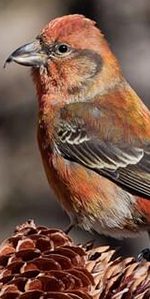| Red Crossbill | ||
 |
Classification(s) : | Prey |
| Cat Name : | Cardinal | |
| Common Name : | Red Crossbill | |
| Scientific Name : | Loxia curvirostra | |
| Other Name(s) : | ||
| Physical Description : | Males range in coloration from deep red to greenish, with unbarred dark brown or black wings and tail feathers. Females are generally gray or dark green, with lighter breast and rump. Both genders have a short tail and a sizable beak with crossed tips. |
|
| Physical Statistics : | Length: 5.5 – 8.0 inches (14 – 20 centimeters) |
|
| Behavior : | The Red Crossbill is highly dependent on the seeds of coniferous trees and will therefore reside year-round in regions where cones are abundant. |
|
| Social Organization : | The Red Crossbill feeds cones even to its young, and is able to breed anywhere it can find sufficient food supplies. |
|
| Approval Level : | None; The Red Crossbill is common in any area with a population of cone-bearing trees. | |
| Kill Difficulty : | Low; The Red Crossbill’s only defense besides flight is its beak and claws. |
|
| Training Level : | Advanced; As Red Crossbills are birds, the hunter must be adept at catching flying creatures. |
|
| Hunting Tactic : | Birds | |
| Food Quality : | Medium; The Red Crossbill is a stockily-built bird but is not overly large. | |
